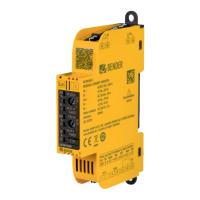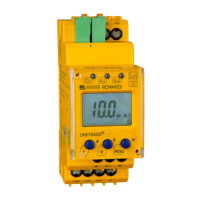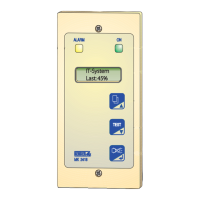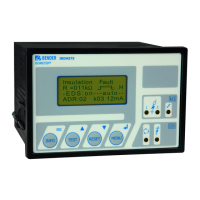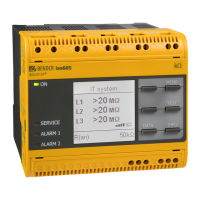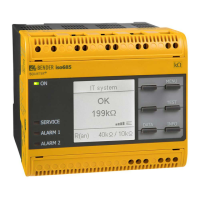Function
11
TGH1442en/06.2012
3.2.5 Functional faults
If an internal functional fault occurs, all of the three LEDs flash. An error code
will appear on the display (E01...E32). In such a case please contact the Bender
Service.
3.2.6 Setting the number of reload cycles
If faults occur only temporarily, but recurrently, in the system being moni-
tored, with the fault memory M deactivated, the alarm relays would switch
synchronously to the error status.
RL in the out menu can be used to limit the number of these changeover proc-
esses. As soon as the preset number of switching cycles is exceeded, the fault
memory will come on and an activated alarm remains stored.
3.2.7 Assigning alarm categories to alarm relays K1/K2
The alarm categories device error, residual current I
Δn1
, residual current I
Δn2
or
alarm by device test can be assigned to the alarm relays via the "out" menu.
3.2.8 Time delays t, t
on
and t
off
The times t, t
on
and t
off,
described below, delay the output of alarms via LEDs
and relays.
3.2.9 Start-up delay t
After connection to the supply voltage U
S
, the alarm indication is delayed by
the preset time t (0...10 s).
3.2.10 Response delay t
on1/2
If the residual current increases above or falls below the response value, the
residual current monitor needs the response time t
an
before it signals an
alarm. A set response delay t
on1/2
(0...10 s) adds up to the device-related oper-
ating time t
ae
and delays alarm signalling (total delay time t
an
= t
ae
+ t
on
). If the
residual current fault does not continue to exist, an alarm will not be signalled.
3.2.11 Delay on release t
off
When no alarm exists after deactivating the fault memory, the alarm LEDs go

